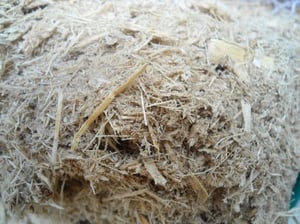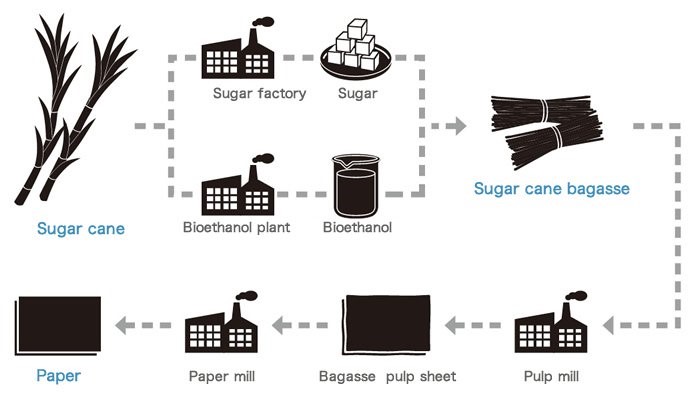
In this week's Sustainable Materials blog, we consider Sugarcane as a sustainable raw material:
Where does it come from?
 Sugarcane, also known as bagasse, is a renewable, fast growing resource that is grown for a number of purposes. Bagasse is the dry pulpy fibrous residue that remains after stalks are crushed to extract their juice.
Sugarcane, also known as bagasse, is a renewable, fast growing resource that is grown for a number of purposes. Bagasse is the dry pulpy fibrous residue that remains after stalks are crushed to extract their juice.
It is used as a biofuel for the production of heat, energy, and electricity, and in the manufacture of pulp and building materials. Once the juice is extracted, the sugarcane stalk is usually incinerated or discarded. For every 10 tonnes of sugarcane crushed, a sugar factory produces nearly three tonnes of wet bagasse. The high moisture content of bagasse (typically 40–50%) is detrimental to its use as a fuel.
However, these crushed stalks can be saved and made into other items before they are thrown away. After the sugar-rich juice is extracted, the leftover canes are collected and turned into pulp. With the addition of water the pulp is turned into paste. This paste can then be pressed into any desired form, creating plates, bowls and boxes among other things.
Due to the high cellulose and fibre content of bagasse, the items produced are not only heat-resistance but also grease and moisture resistant. Since these items are made from a natural renewable resource they are 100% compostable.

The production flow of sugarcane/bagasse paper.[1]
What is its impact?
We know that forests are threatened and endangered around the world, therefore finding alternative materials that do not require virgin forest resources is urgent and important. With bagasse, high performing disposable "paper" products can be used, knowing that the product chosen is made from rapidly renewable and reclaimed sugarcane instead of trees. Best of all, at the end of its life, products can be placed into commercial compost instead of landfill. Since sugarcane is used before it gets discarded, the stalk is considered a "reclaimed resource". Therefore fewer trees are needed to make the products and reclaimed waste that would otherwise be burned or landfilled is actually put to use. Unfortunately commercial compost facilities that accept food waste are not yet that widespread.
The polymer created from sugarcane waste is bio-based rather than oil-based. During the growth of the sugarcane, the natural process of photosynthesis sees carbon actively captured, meaning the polymer is initially carbon negative. The amount of captured carbon is almost equivalent to the amount of carbon expended when using oil-based polymers. Furthermore, it’s worth noting that sugar cane polymers are a renewable resource and don’t deplete fossil fuels, unlike their oil-based counterparts, which is a big environmental benefit. But, whilst it starts off as carbon negative, the production process inevitably generates carbon through factors such as transport and electricity use, which means that by the time the bio-based polythene is produced it is actually carbon neutral as opposed to carbon negative. Being bio-based means that renewable sources are used and there’s no loss of valuable non-renewable fossil fuels. Being non-biodegradable means that the polythene can be used in the recycling mix indefinitely. It’s worth noting though, that it’s essential that the sugarcane polythene is 100% recyclable. That way it can be continually of use. Unfortunately, currently sugar cane polymer, when compared against its oil alternative, is undeniably more expensive to produce.
There are processing options that can help to reduce this cost impact. Using the latest extrusion techniques, and specialist polymers, it’s possible to offset the cost of the sugarcane polymers by reducing the thickness. This reduction in thickness can be by as much as 20 to 30%, meaning less material is used and therefore less cost is involved. This saving can also be applied to a business’s carbon footprint – less polythene means less carbon, and therefore a smaller carbon impact, further enhancing its environmentally friendly credentials. This thinner polythene, when combined with sugarcane polythene, offers the potential for a ground-breaking cost neutral, zero carbon impact product.
Uses and properties
It is widely perceived that paper products are environmentally friendly, given its ability to compost and bio-degrade, as well as its classification as a renewable resource. However, its production requires cutting down large quantities of trees. National geographic has reported that approximately 18.7 million acres of forest are cut down each year, resulting in a loss of habitat for millions of animal species, as well as degradation of our ability to reduce carbon dioxide (absorbed by trees during photosynthesis), further contributing to the greenhouse effect and warming of our planet. Harmful chemicals such as bleach are also commonly used to achieve the desired whitening effect, and additional materials such as plastic linings need to be added for end products to be suitable as food packaging. This makes the end product much more difficult to recycle (as the materials need to be separated) and prevents the product from fully bio-degrading. Plastics are produced from petroleum, a non-renewable resource of which the production poses many impacts on our environment. However, the most significant issue is that plastic does not degrade naturally over time and therefore any plastic product not recycled or disposed of correctly can build-up and cause harm to our environment.
On the other hand, bagasse is a natural resource that is 100% compostable, meaning that if it does enter our environment, it will break down into soil entirely naturally, without any human intervention or additional processing. Sugarcane based polythene has a number of uses. It can be used to create bags, covers, tubes, films, wraps and stretch film, which means there are a wide variety of functions to which it can be applied.
Properties of Bagasse
- Sustainably sourced with little or no environmental impact.
- 100% compostable and will break down to compost if left in the natural environment.
- No additional additives or chemicals are needed to whiten or strengthen it.
- Quick replenishment of crops, with sugarcane being harvested in a single season.
- Grease and water resistant with no added chemicals needed.
- High resistance to temperature, easily withstands up to 95 degrees, microwave and freezer safe.
- High strength and durability.
- Highly insulating.
- Does not degrade prematurely, only starting to compost a few weeks after it has been exposed to natural elements.
Some interesting Facts[2]
- In the UK this year alone, 10.8 billion wet wipes, 16.5 billion pieces of plastic cutlery, 42 billion plastic straws and 4.1 billion single-use drinks cups and lids have been thrown away (statistics by the WWF).
- Greenpeace state that around 12.7 million tonnes of plastic products end up in our oceans each year having a devastating effect on the marine life that occupies them.
- Sugarcane already binds CO2 during growth
- The UK uses some 1 million tonnes of polythene films and bags every year. Using fossil fuel polymers to meet this demand costs the planet 2.6 billion tonnes of CO2 annually.
- A Life Cycle Assessment of the manufacturer has shown that 2.15kg CO2/kg Bio-HDPE will be absorbed by the time the Bio-HDPE is produced. In comparison, 1.83kg CO2/kg HDPE are produced during the production of the conventional plastic in the same company
Are you looking for innovative, sustainable marketing services support? Contact us to discover how ASL can help your marketing campaigns become more environmentally sustainable and socially responsible.
[1] https://www.buzzcateringsupplies.com/catering-blog/article/what-is-bagasse-material
[2] https://www.rose-plastic.co.uk/en/company/sustainability/plastic-packaging-made-from-sugarcane/
ASL Global is committed to conducting our business in a responsible & sustainable way. Acting with passion and integrity, our people work with customers, suppliers and other stakeholders to make a positive contribution to social responsibility and environmental sustainability in communities around the world.

Discover more about our ONE WORLD initiative







